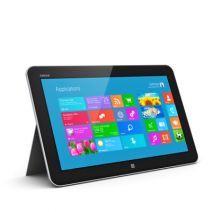Britek Solutions Blog
How Windows Tablets Can Enhance Your Business, Part II
 In part one, we provided an overview of Microsoft’s newest foray into mobile computing and how they’ve finally arrived after years of trying to implement a mobile strategy. In this part, we will provide you with specific technology that your business can potentially employ to utilize Windows-based tablets to improve your organization’s mobility.
In part one, we provided an overview of Microsoft’s newest foray into mobile computing and how they’ve finally arrived after years of trying to implement a mobile strategy. In this part, we will provide you with specific technology that your business can potentially employ to utilize Windows-based tablets to improve your organization’s mobility.
There are three major factors that will see Windows-based tablets become more relevant for business computing. They are integration, security, and simplicity. Microsoft has developed platforms that present options that other mobile computing platforms cannot match, and as the technology becomes more commonplace for productivity, you’ll likely see the Windows-based tablets substantially increase their mobile market share.
The first element of Windows-based tablet computing is the availability of machines that allow users to actually be productive while they’re on the go. Tablets are mostly known as consumption-first devices. This traditionally has more to do with their lack of decent software with which to complete work, as well as the touchscreen interface that’s difficult for users to enter commands.
Security is strong on Windows 8.1 tablets. Since the OS was developed to run on PCs and mobile devices alike, the software comes with some of the best security features that come on a mobile OS. These include comprehensive device encryption to secure data and a tamper-resistant booting process that prevents unauthorized access and low-level malware infections, respectively.
This kind of static computing interface allows users to learn one set of software, which is important when using mobile devices for productivity. Many of today’s Windows tablets run full versions of Windows 8.1, which, unlike other tablet OSs, comes with the very same interface that you would get on a PC. This allows users to familiarize themselves with one piece of software instead of many. The ease-of-use factor significantly contributes to the viability of the device, and with a stylus, the Windows 8.1 tablet is familiar and simple.
While Windows tablets have failed to generate the demand that Apple’s iPad or devices running the Android environment have, there has been a pretty drastic shift recently. To alter this course, Microsoft has made a dedicated effort to promote their line of Surface tablets as able to provide a consistent computing interface on each environment, while providing users with a state-of-the-art computing interface for productivity, not just consumption.
Devices
Three of the most popular tablets available with the Windows 8.1 OS include:
Microsoft Surface Pro 3 - This is Microsoft’s flagship device. They’ve been positioning this device as a completely viable laptop replacement, and if your laptop is a couple of years old, they certainly have a point. The device has a 12.6” screen and comes with a proprietary stylus. The available type cover has been renovated from other versions of the Surface line of tablets.
ASUS Transformer Book - ASUS manufactured, running full Windows 8.1, the Asus Transformer Book T200 has a large 11.6” display and comes with a keyboard.
Samsung XE500 - The world’s largest mobile device manufacturer has gotten in on the action as well with the XE500. Also with an 11.6” display with an attachable keyboard, it also comes with a Livescribe Smartpen stylus.
Windows 10: Microsoft’s Next All-In-One Strategy
As Microsoft begins rolling out their newest OS, Windows 10, the plan is for all levels of the platform to provide the same computing environment, essentially merging the tablet and the PC like never before. This shift is going to change the game for companies that are searching for ways to improve its mobility.
Microsoft has announced its Windows 10 release date: July 29, 2015. Subsequently, they have already sent notifications to users of older versions, asking them to reserve their free copy. To give you an idea of what to expect, here are seven new Windows 10 mobile features from International Business Times:
- Clutter-free interface.
- A new settings menu that will allow you to access your preferences universally across all your Windows 10 devices.
- A new Internet browser, Edge, will be featured across all Windows 10-based devices and be able to organize your bookmarks, history, and RSS feeds across all your devices.
- All-in-one messaging and calling that will feature an integrated message center by drawing all your text messages, Skype messages, and from any other third party message apps.
- A floating keyboard with well-laid buttons and voice-typing ability.
- Universal apps will allow you to use the same version of apps across your Windows devices.
- Free to upgrade for licensed Windows users.
The advancements and improvements made by Microsoft to its mobile platforms make it an attractive and practical option for businesses looking to expand beyond traditional desktops. If you’re looking to implement an effective mobile technology strategy for your business, then call us at (954) 560-8145 to learn more.
When you subscribe to the blog, we will send you an e-mail when there are new updates on the site so you wouldn't miss them.

Comments